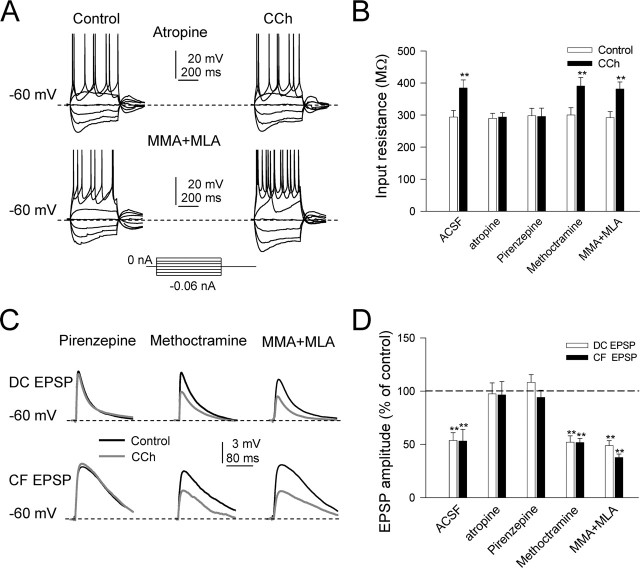Figure 4.
Both presynaptic and postsynaptic effects of CCh are exclusively via activation of M1 muscarinic receptors. A, Top, Representative current-clamp responses evoked by depolarizing and hyperpolarizing current pulses in control ACSF and with 10 μm CCh obtained 10 min after the onset of superfusion with atropine (1 μm). Note the absence of the cholinergic effects. A, Bottom, Same as A, top, but under MMA (50 μm) and MLA (0.1 μm); note the unchanged CCh effects with nicotinic antagonists. B, Summary data showing the mean input resistance (in megaohms) in control (open bars) and during CCh (filled bars) with control ACSF (n = 10; p < 0.01), atropine (n = 10; p > 0.05), pirenzepine (n = 6; p > 0.05), methoctramine (n = 6; p < 0.01), and MMA plus MLA (n = 9; p < 0.01). C, Top, Superimposed DC-EPSPs in control (black trace) and during CCh (gray trace) when superfusing pirenzepine, methoctramine, and MMA plus MLA. C, Bottom, Same as C, top, but for CF-EPSC. Note that only pirenzepine blocks the presynaptic inhibition of EPSCs. D, Summary data showing mean DC-EPSP and CF-EPSP amplitudes (open and filled bars, respectively) during 10 μm CCh (represented as a percentage of control amplitudes) in control ACSF (n = 10; p < 0.01), atropine (n = 10; p > 0.05), pirenzepine (n = 6; p > 0.05), methoctramine (n = 6; p < 0.01), and MMA plus MLA (n = 9; p < 0.01).

